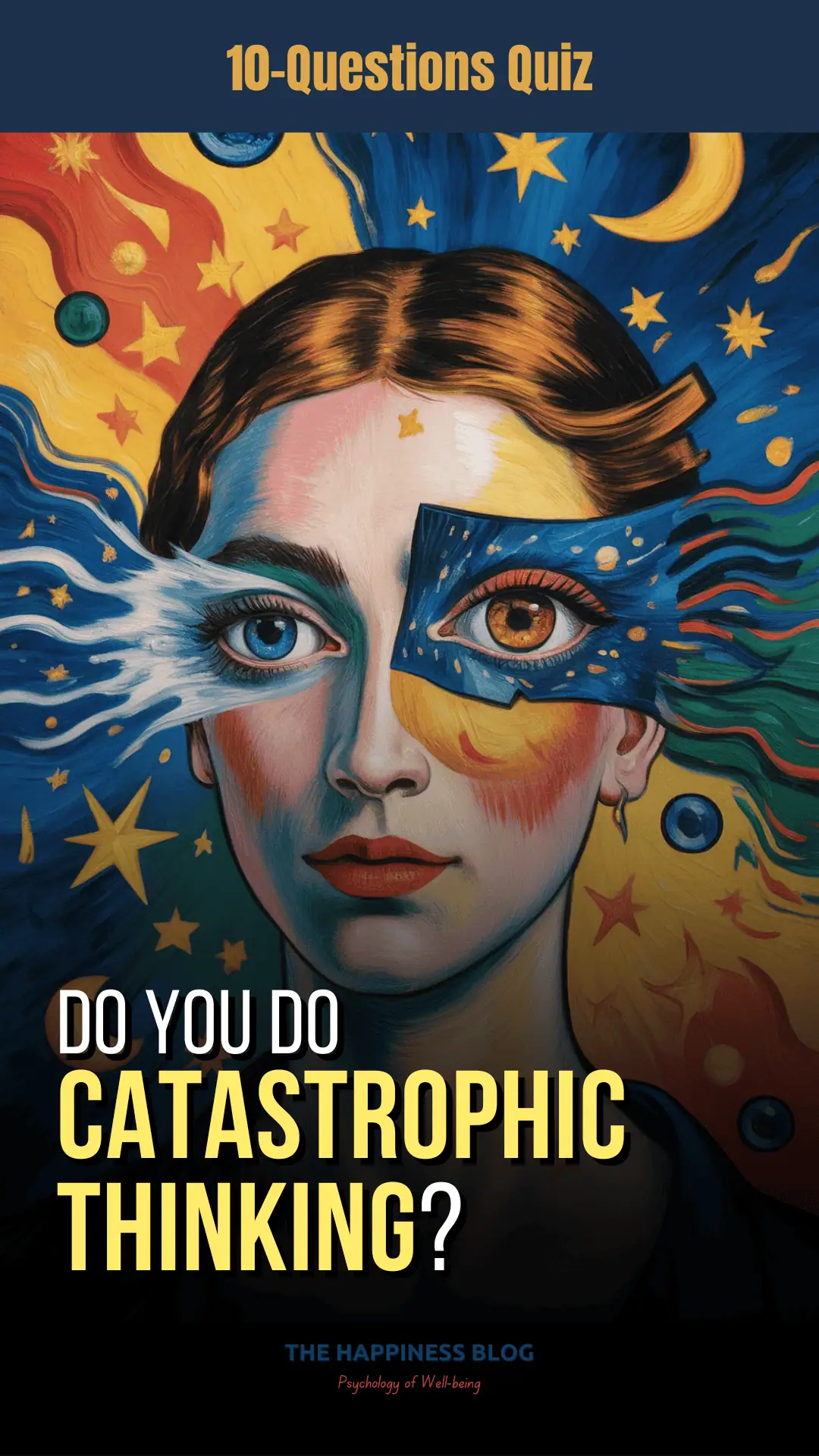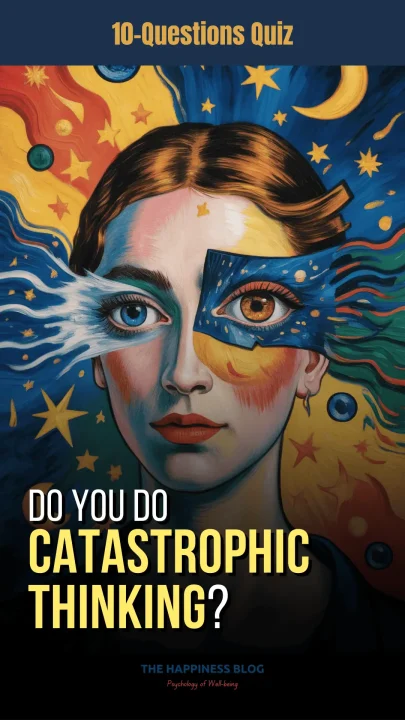Today's Friday • 5 mins read
Are you often caught up in thoughts of worst-case scenarios?
A small mistake at work feels like a career-ending disaster. A delayed text from a loved one means they are breaking up. A simple headache morphs into a life-threatening condition.
Welcome to catastrophic thinking or catastrophizing. Catastrophizers are much more than worriers. They blow up their little fears and anxieties into terrible things that may (almost) never happen.
Do you relate to that? Find out first. Then read on to know how to stay calm and handle things in a balanced way.
Do You Do Catastrophic Thinking? A Quick Check!
Wondering if you tend to imagine the worst-case scenario? This brief, informal quiz encourages self-reflection on thought patterns linked to catastrophic thinking. It’s not a diagnostic tool but offers insight into your mindset.
Your Catastrophic Thinking Score: /50
Interpretation: A higher score indicates a stronger tendency toward catastrophic thinking, which may amplify worry or anxiety.
- 10–20: You maintain a balanced perspective, rarely jumping to worst-case scenarios. Keep nurturing this resilience!
- 21–35: You occasionally fall into catastrophic thinking, especially under stress. This is common and manageable with mindful strategies.
- 36–50: You may frequently anticipate disasters, which could heighten anxiety. Consider exploring techniques like cognitive reframing or professional support.
This quiz is for personal reflection and is not a substitute for professional evaluation. Catastrophic thinking can contribute to anxiety, but tools like therapy or mindfulness can help. If these thoughts disrupt your daily life, a mental health professional can offer personalized guidance.
Psychology of Catastrophic Thinking
Psychologist Albert Ellis described “catastrophizing” as the tendency to magnify a perceived threat and overestimate the seriousness of its potential consequences.
Catastrophic thinking is a cognitive bias – a faulty way your brain prepares for disaster. It assumes the worst possible outcome when a small thing goes wrong. And triggers your nervous system to go into high alert, trying to protect you from danger from a threat that doesn’t exist.
It has a background of fear and anxiety, natural survival mechanisms to keep us safe by scanning for threats. In modern life, life-threatening events are rare, but our brains may still misread everyday challenges as life-or-death emergencies.
- Catastrophic thoughts can worsen the symptoms of anxiety, depression, OCD, PTSD, or ADHD.
- Chronic stress from catastrophic thinking can cause headaches, sleep issues, and fatigue.
- Relationships suffer when you constantly expect the worst from people.
- Work performance declines when you’re paralyzed by fear of failure.

Types of Catastrophic Thinking
Catastrophic thinking may present as:
- Personalization: Blaming yourself for things completely outside your control.
- Overgeneralization: Taking one bad experience and deciding it represents your entire future.
- Mental Filtering: Focusing only on what went wrong while ignoring everything that went right.
- All-or-Nothing Thinking: Viewing situations as either perfect or completely terrible, with no middle ground.
- Jumping to Conclusions: Assuming the worst without evidence, such as thinking you’re getting fired because your boss wants to meet or believing a quiet friend now hates you.
How To Stop Catastrophic Thinking
- Use the 10-10-10 rule. Will this matter in 10 minutes? 10 months? 10 years? This perspective shift helps you see that most of your daily worries are temporary blips, not permanent disasters.
- Challenge your thoughts. When catastrophic thinking strikes, ask yourself: “Is this thought based on facts or fears?” Search for evidence that supports or contradicts your worst-case scenario. Often, you’ll find your fears are built on assumptions rather than reality.
- Practice the “so what?” technique. Even if your fear comes true, what would actually happen? Let’s say you do make a mistake at work. Would you really get fired? Would it actually ruin your entire career? Usually, the real consequences are much more manageable than your imagination suggests.
- Develop mindfulness skills. Mindfulness teaches you to observe your thoughts without getting caught up in them. When you notice catastrophic thinking starting, you can acknowledge it without believing it or acting on it.
- Reframe your inner dialogue. Instead of “This is terrible and everything is ruined,” try “This is challenging, but I can handle it.” Replace “What if something goes wrong?” with “What if something goes right?”
- Seek Professional Help. Cognitive Behavioral Therapy (CBT) is particularly effective for catastrophic thinking.
Building Your Defense System Against Catastrophic Thinking
Preventing is easier than stopping it once catastrophic thinking starts. To prevent it
- Get a habit of regular exercise to reduce your anxiety and keep your mood up.
- Talk to people who are fun to be with; they can nudge you to avoid negative thought spirals. Trusted friends and family can offer you a non-catastrophic perspective and remind you that your worst fears are rarely accurate.
- Get adequate sleep (7-8 hours nightly) to keep your brain functioning optimally and better able to handle stress.
- Create a daily routine of relaxation. Deep breathing, meditation, or even a few minutes of quiet reflection can help keep your nervous system calm and your thoughts balanced.
- Be patient with yourself as you learn new mental habits. Each time you catch yourself catastrophizing and choose a different response, you’re rewiring your brain for greater peace and resilience.
Final Words
Albert Ellis developed the Rational Emotive Behavior Therapy (REBT) around the ABC model:
- Activating event (the trigger event),
- Beliefs (beliefs about the event), and
- Consequences (emotional and behavioral consequences).
Remember: your thoughts are not facts. Just because you think something doesn’t make it true. You have the power to question, challenge, and change the thoughts that no longer serve you.
The goal isn’t to eliminate all worry or concern from your life. Some anxiety is normal and even helpful. The goal is to stop flowing with imaginary disasters with overwhelming panic.
You can train your mind to be your ally rather than your enemy. Start today, one thought at a time.
• • •
√ Also Read: Psychopath vs. Sociopath – How They Truly Differ?
√ Please share this if you found it helpful.
» You deserve happiness! Choosing therapy could be your best decision.
...
• Disclosure: Buying via our links earns us a small commission.
